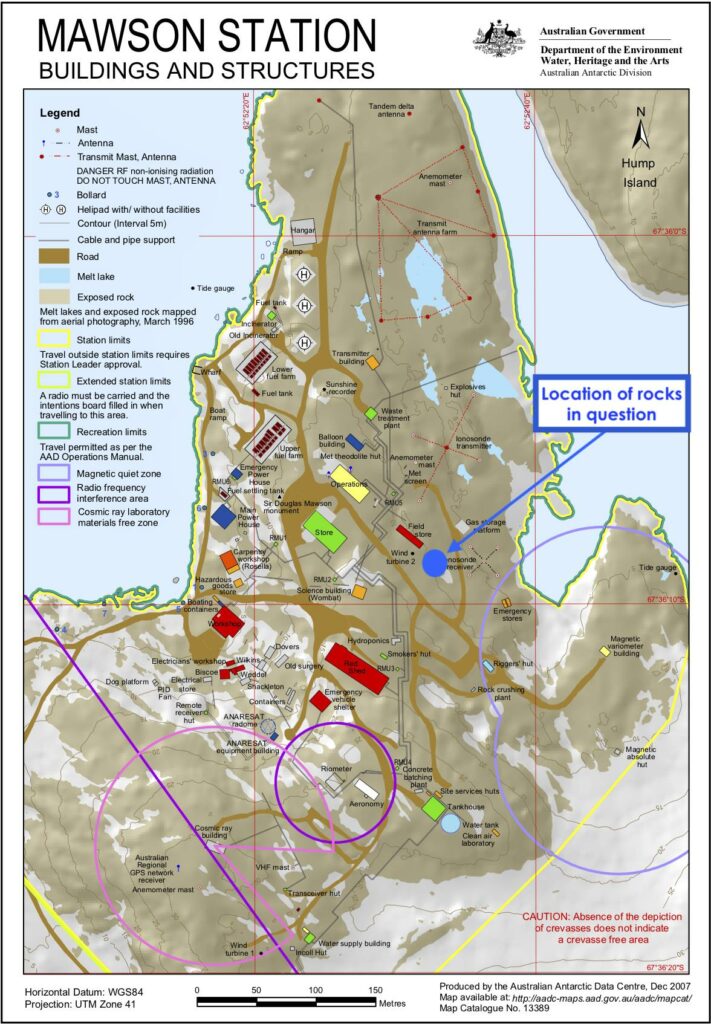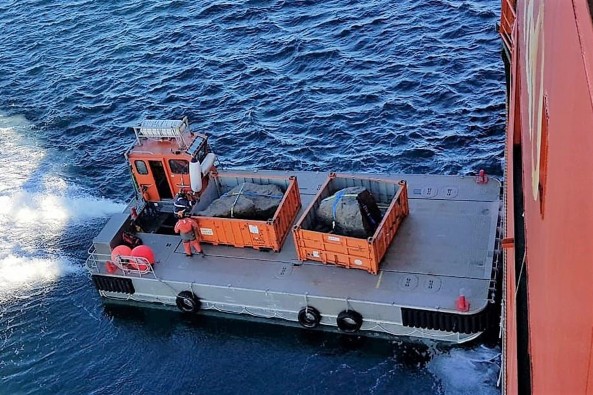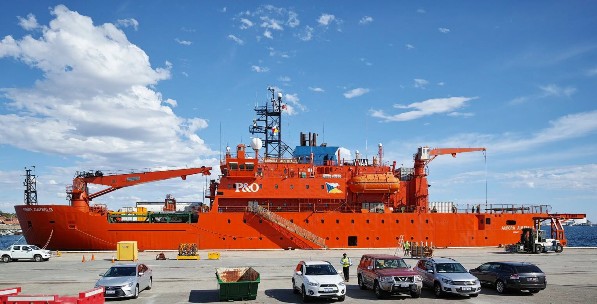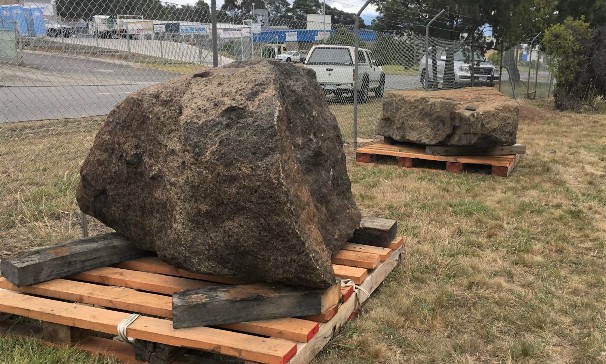
A small piece of Antarctica for the National Rock Garden
Author: Ken McQueen, NRG Steering Committee member
Extract from National Rock Garden Newsletter No. 17, April 2019
The latest donations to the National Rock Garden are two magnificent samples of Mawson Charnockite from Antarctica.
Charnockites are granite-like rocks typically composed of quartz, K-feldspar, plagioclase and orthopyroxene. They are found in high temperature-high pressure metamorphic areas of the Earth’s crust, but ideas on their origin have been controversial. Once thought to be igneous rocks crystallised from magmas, because of their granular texture, they are now generally considered metamorphic rocks formed by deep crustal, high- temperature and high-pressure metamorphism, or possibly igneous rocks subsequently subjected to such metamorphism. Charnockites are distributed throughout the Precambrian shield areas of the southern continents (formerly making up Gondwana). In Australia, they are found near Cape Leeuwin and Cape Naturaliste near Albany, Esperance Bay, Eyre Peninsula, and the Musgrave Ranges.

The name charnockite was proposed by T.H. Holland in 1893 to honour Job Charnock who was an employee and administrator of the English East India Company. Controversially considered the founder of Calcutta (modern day Kolkata in India), Job died in 1693 and was buried in a simple grave at St John’s Church, Calcutta. In 1695 Job’s son-in-law, Sir Charles Eyre, erected a mausoleum over his tomb. The polished and engraved tombstone is made from dark greenish rock mined from St Thomas Mount near Chennai and subsequently named charnockite.
The Mawson Charnockite occurs around Mawson Station, one of Australia’s three research bases in Antarctica. Both the station and the rock are named after Sir Douglas Mawson, Australia’s most famous Antarctic explorer and a prominent geologist. Originally informally named the Mawson Granite by Chron (1959), it was later formally defined as Mawson Charnockite by Trail (1970). The rock is described as a brown, gneissic charnockite with a slight to moderate foliation and numerous xenoliths. Where its contacts with other rocks are exposed, it appears to be intrusive into these rocks. The Mawson Charnockite has been dated at around 954 million years (Australian Stratigraphic Units Data Base, 2019).

The inspiration for including a sample of the Mawson Charnockite in the National Rock Garden came from the late Professor Patrick Quilty. Professor Quilty was a palaeontologist and geologist who was passionate about Antarctic geoscience and its promotion internationally. He made many research trips to Antarctica and rose to the position of Chief Scientist with the Australian Antarctic Division from 1981 to 1999. He also had a long association with the international Scientific Committee on Antarctic Research, including as Vice President.
Patrick believed that a piece of Antarctica from Australia’s Antarctic Territory would be a fitting memorial to the work of Sir Douglas Mawson and other Australian geologists and scientists who have contributed to understanding the frozen continent. The rock also provides a reminder of the geological connections of Australia to the other southern continents as part of Gondwana.
The National Rock Garden has arranged with the Australian Antarctic Division to receive two large blocks Mawson Charnockite. These will be the first specimens organised for the NRG that come from the Australian Territories.
The specimens designated for shipment on the research vessel Aurora Australia (see image below) were selected by senior staff of the Australian Antarctic Division. The location of the samples at Mawson Research Station is shown on the map above.

Image courtesy the Australian Antarctic Division.

Image courtesy R.N. England.
After receiving customs and quarantine clearance, the two large rocks were transported to the Mineral Resources Tasmania (MRT) Core Storage Facility at Mornington on the 22nd of March. The rocks were placed carefully up against the inside of the security fence, as directed by senior MRT staff (see image). They will be securely stored on the wooden pallets at the Core Storage Facility until sufficient funding is raised to provide for the shipment of the rocks to Canberra and preparation of the specimens for display.

Image courtesy Steve Newett.
The National Rock Garden acknowledges the Australian Antarctic Division for the donation of these samples and their assistance in transporting them from Antarctica to Tasmania. The NRG Steering Committee also thanks Mineral Resources Tasmania for agreeing to safely store the rocks until they can be transported to Canberra.
References
Mawson Charnockite details, Australian Stratigraphic Units Data Base, 2019. https://asud.ga.gov.au/search-stratigraphic-units/results/11477
Crohn, P.W., 1959. A contribution to the geology and glaciology of the western part of Australian Antarctic Territory. Bureau of Mineral Resources Australia, Bulletin No. 52.
Holland, T.H., 1900. The charnockite series, a group of Archaean hypersthenic rocks in Peninsular India. Memoir Geological Survey of India, 28.
Trail, D.S., 1970, ANARE 1961 geological traverses on the MacRobertson Land and Kemp Land Coast. Bureau of Mineral Resources, Australia, Report, 135.


